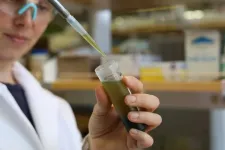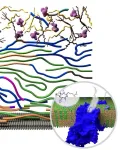(Press-News.org) How do foraging animals find their food? A new study by New York University researchers shows that lemurs use smell, social cues, and long-term memory to locate hidden fruit—a combination of factors that may have deep evolutionary roots.
“Our study provides evidence that lemurs can integrate sensory information with ecological and social knowledge, which demonstrates their ability to consider multiple aspects of a problem,” said anthropologist Elena Cunningham, a clinical professor of molecular pathobiology at NYU College of Dentistry and the lead author of the study, published in the International Journal of Primatology.
Animals rely on their senses and environmental and social knowledge to locate food and water. These factors—perhaps in combination—are thought to have played a role in primates evolving to have larger brains and higher cognitive abilities than other animals.
“Historically, there have been two schools of thought on why primates developed bigger brains: ecological pressures, such as needing to find scarce fruit in the forest, and the social pressures of living in a group where everyone is trying to outsmart one another,” said Cunningham. “I have long been interested in the interplay between social and ecological factors when it comes to cognition—it seems like a given that these would have evolved in relation to each other.”
To better understand how primates integrate these factors in order to find food, Cunningham traveled to the Lemur Conservation Foundation in Myakka City, Florida, a reserve dedicated to researching and protecting lemurs outside of their native Madagascar. The Foundation is home to several lemur species, including brown lemurs—social animals who have a keen sense of smell (far better than humans) and whose diet is primarily fruit.
Studying the brown lemurs in pairs and groups of three, the researchers conducted several experiments by hiding pieces of cantaloupe in cardboard takeout containers and placing both fruit-filled and empty containers in the lemurs’ environments. They then observed how the groups of lemurs investigated and opened the containers, noting their interactions with one another.
Despite the empty takeout containers outnumbering the ones with cantaloupe, the lemurs had little trouble finding and eating the fruit—and several factors appeared to be working in tandem. The lemurs quickly learned which containers had food in them, and could remember the location of the fruit-filled containers days, weeks, and even months later: the order in which they approached baited containers was about 50 percent better than chance. But, the lemurs almost always (98 percent of the time) opened the fruit-filled containers first, suggesting that they used their sense of smell to detect the cantaloupe at close range.
In addition, the researchers observed that the lemurs’ individual strategies for finding fruit were influenced by social factors. Some groups were egalitarian and information and melon were willingly shared, while in other more hierarchical groups, the dominant lemurs took advantage of the subordinates discovering the cantaloupe and helped themselves once the fruit was found. But the subordinates were more likely to find the fruit and some used their “finder’s advantage” to eat more of the melon.
“What our study shows is that these three factors are all operating at the same time—the lemurs have memories of where the food is and they are considering olfactory information and social factors,” said Cunningham. “We still have much to learn about how this interplay and the evolution of cognition, but it's important to look at these factors not in isolation, but in conversation.”
Additional study authors include Malvin Janal, Rachelle Wolk, and Maria Gonzalez-Robles of NYU Dentistry. The research was supported by the NYU Research Challenge Fund Program and NYU College of Dentistry Academy of Distinguished Educators Funding Award.
END
Lemurs use long-term memory, smell, and social cues to find food
Multiple factors work in tandem to help lemurs locate cantaloupe and remember where to find the fruit weeks later
2024-08-07
ELSE PRESS RELEASES FROM THIS DATE:
New research challenges conventional wisdom on wet surface adhesion
2024-08-07
Scientists at the University of Akron and the University of Pittsburgh have overturned long-held assumptions in new research that finds water can be a help for adhesion.
Dr. Ali Dhinojwala, distinguished W. Gerald Austen Endowed Chair and H.A. Morton Professor at The University of Akron’s School of Polymer Science and Polymer Engineering, lead a team whose significant breakthrough — that water can unexpectedly enhance adhesion under controlled conditions — was published Aug. 7 in Science Advances.
The implications of this research are profound, particularly in biomedical applications ...
Newly published report outlines findings from first archaeology project in space
2024-08-07
The first-ever archeological survey in space has provided new insights into how astronauts use and adapt their living space on the International Space Station, which could influence the design of new space stations after the ISS is decommissioned.
Findings from the research team behind the International Space Station Archaeological Project (ISSAP) were published today in the journal PLOS ONE. Archaeologist Justin Walsh of Chapman University is available to discuss the discoveries of the team’s first on-orbit project, the Sampling Quadrangle Assemblages Research Experiment (SQuARE).
While Earth-bound archaeologists dig one-meter squares to understand ...
Memory loss in aging and dementia: Dendritic spine head diameter predicts memory in old age
2024-08-07
BIRMINGHAM, Ala. – Over the course of life, memory fades with varying degrees, robbing older people of the ability to recollect personal experiences. This progressive, nearly inevitable process has long been hypothesized as a consequence of nature’s removal of dendritic spines, a key component of synapses, from brain neurons as they age.
A study published in Science Advances led by researchers at the University of Alabama at Birmingham and Rush University Medical Center, Chicago, Illinois, now provides evidence that the preservation of past life experiences ...
Birmingham host to investigational treatment trial which could improve outcomes of pregnancies affected by severe haemolytic disease
2024-08-07
Pregnant mothers have taken part in a clinical study (the UNITY trial) in Birmingham, which has found that nipocalimab, an investigational, fully human, monoclonal antibody, has the potential to improve the survival rate of unborn babies with rare, early-onset fetal anaemia, as a result of haemolytic disease of the fetus and newborn (EOS-HDFN).
The study investigated pregnancies complicated by severe EOS-HDFN (RhD (D) or Kell (K) alloimmunized pregnant individuals with singleton pregnancies) and evaluated the effects of nipocalimab at weekly intervals from 14-35 ...
Drug trial for rare fetal blood disease shows promise for less invasive approach
2024-08-07
AUSTIN, Texas — Data from a new investigational drug that could alter the standard treatment for a rare blood disease suggests it has the potential to delay or prevent anemia and the need for intrauterine blood transfusions in babies who are at high risk for the condition, known as Hemolytic Disease of the Fetus and Newborn (HDFN). Results of the Phase 2 clinical trial of the drug nipocalimab were published today in The New England Journal of Medicine.
HDFN is a serious condition in which the blood types of the mother and her fetus do not match, potentially causing life-threatening anemia in the baby. The current ...
Forever chemical pollution can now be tracked
2024-08-07
Organofluorine compounds — sometimes called ‘forever chemicals’ — are increasingly turning up in our drinking water, oceans and even human blood, posing a potential threat to the environment and human health.
Now, researchers at The University of Texas at Austin have developed a way to fingerprint them, which could help authorities trace them to their source when they end up in aquifers, waterways or soil.
The technique involves passing samples through a strong magnetic field then reading the burst of radio waves their atoms emit. This reveals ...
How fungi elude antifungal treatments
2024-08-07
Every year, life-threating invasive fungal infections afflict more than 2 million individuals globally. Mortality rates for these infections are high, even when patients receive treatment.
Aspergillus fumigatus, the most frequent cause of invasive fungal infection in people with suppressed immune systems, is responsible for approximately 100,000 deaths annually around the world. Poor treatment outcomes result from therapeutic failures and the fungi’s resistance to existing drugs.
A new multi-institutional study led by researchers at Michigan State University has characterized how fungi adapt to restructure their cell walls, effectively ...
ACC Asia 2024 explores emerging trends, evidence-based strategies for improving global heart health
2024-08-07
The American College of Cardiology (ACC) and the Cardiological Society of India will host ACC Asia 2024 on August 16-18 in Delhi, India. This conference will bring together all members of the cardiac care team to examine emerging trends and best practices for cardiovascular disease patient care.
“One of the most meaningful outcomes of the annual ACC Asia conference is the ability to communicate with other cardiologists to strategize and innovate new ideas,” said Eugene Yang, MD, MS, FACC, one of the ACC Asia conference co-chairs. “As ...
CalTech team develops first noninvasive method to continually measure true blood pressure
2024-08-07
Solving a decades-old problem, a multidisciplinary team of Caltech researchers has figured out a method to noninvasively and continually measure blood pressure anywhere on the body with next to no disruption to the patient. A device based on the new technique holds the promise to enable better vital-sign monitoring at home, in hospitals, and possibly even in remote locations where resources are limited.
The new patented technique, called resonance sonomanometry, uses sound waves to gently stimulate resonance ...
Using photos or videos, these AI systems can conjure simulations that train robots to function in physical spaces
2024-08-07
Researchers working on large artificial intelligence models like ChatGPT have vast swaths of internet text, photos and videos to train systems. But roboticists training physical machines face barriers: Robot data is expensive, and because there aren’t fleets of robots roaming the world at large, there simply isn’t enough data easily available to make them perform well in dynamic environments, such as people’s homes.
Some researchers have turned to simulations to train robots. Yet even that process, which often involves a graphic designer ...
LAST 30 PRESS RELEASES:
There are new antivirals being tested for herpesviruses. Scientists now know how they work
CDI scientist, colleagues author review of global burden of fungus Candida auris
How does stroke influence speech comprehension?
B cells transiently unlock their plasticity, risking lymphoma development
Advanced AI dodel predicts spoken language outcomes in deaf children after cochlear implants
Multimodal imaging-based cerebral blood flow prediction model development in simulated microgravity
Accelerated streaming subgraph matching framework is faster, more robust, and scalable
Gestational diabetes rose every year in the US since 2016
OHSU researchers find breast cancer drug boosts leukemia treatment
Fear and medical misinformation regarding risk of progression or recurrence among patients with breast cancer
Glucagonlike peptide-1 receptor agonists and asthma risk in adolescents with obesity
Reviving dormant immunity: Millimeter waves reprogram the immunosuppressive microenvironment to potentiate immunotherapy without obvious side effects
Safety decision-making for autonomous vehicles integrating passenger physiological states by fNIRS
Fires could emit more air pollution than previously estimated
A new way to map how cells choose their fate
Numbers in our sights affect how we perceive space
SIMJ announces global collaborative book project in commemoration of its 75th anniversary
Air pollution exposure and birth weight
Obstructive sleep apnea risk and mental health conditions among older adults
How talking slows eye movements behind the wheel
The Ceramic Society of Japan’s Oxoate Ceramics Research Association launches new international book project
Heart-brain connection: international study reveals the role of the vagus nerve in keeping the heart young
Researchers identify Rb1 as a predictive biomarker for a new therapeutic strategy in some breast cancers
Survey reveals ethical gaps slowing AI adoption in pediatric surgery
Stimulant ADHD medications work differently than thought
AI overestimates how smart people are, according to HSE economists
HSE researchers create genome-wide map of quadruplexes
Scientists boost cell "powerhouses" to burn more calories
Automatic label checking: The missing step in making reliable medical AI
Low daily alcohol intake linked to 50% heightened mouth cancer risk in India
[Press-News.org] Lemurs use long-term memory, smell, and social cues to find foodMultiple factors work in tandem to help lemurs locate cantaloupe and remember where to find the fruit weeks later





